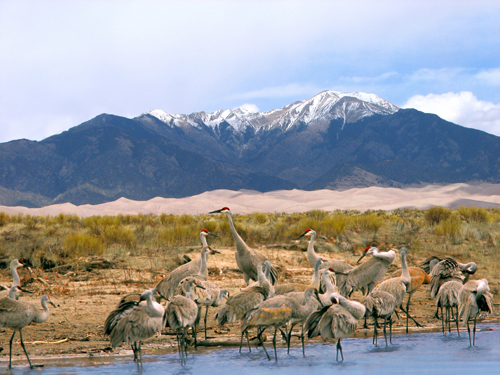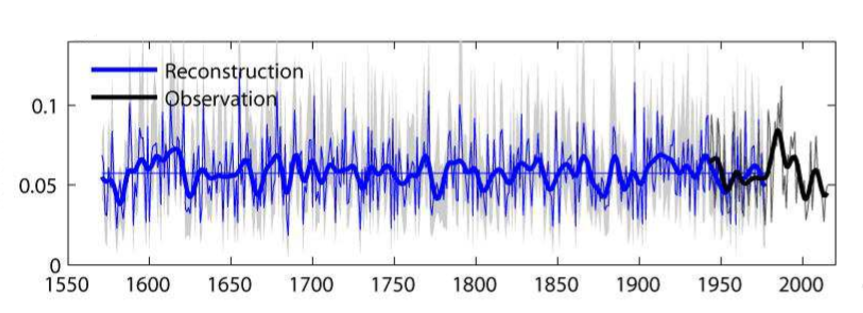Warmer temperatures cause decline in key runoff measure
Finding could improve water supply forecasting
May 11, 2017 - by Staff
May 11, 2017 - by Staff
BOULDER, Colo. — Since the mid-1980s, the percentage of precipitation that becomes streamflow in the Upper Rio Grande watershed has fallen more steeply than at any point in at least 445 years, according to a new study led by the National Center for Atmospheric Research (NCAR).
While this decline was driven in part by the transition from an unusually wet period to an unusually dry period, rising temperatures deepened the trend, the researchers said.
The study paints a detailed picture of how temperature has affected the runoff ratio — the amount of snow and rain that actually makes it into the river — over time, and the findings could help improve water supply forecasts for the Rio Grande, which is a source of water for an estimated 5 million people.
The study results also suggest that runoff ratios in the Upper Rio Grande and other neighboring snow-fed watersheds, such as the Colorado River Basin, could decline further as the climate continues to warm.
 Sandhill cranes in the San Luis Valley of Colorado. The mountains ringing the valley form the headwaters of the Rio Grande River, which flows south into New Mexico and along the border between Texas and Mexico. (Photo courtesy of the National Park Service.)
Sandhill cranes in the San Luis Valley of Colorado. The mountains ringing the valley form the headwaters of the Rio Grande River, which flows south into New Mexico and along the border between Texas and Mexico. (Photo courtesy of the National Park Service.)
"The most important variable for predicting streamflow is how much it has rained or snowed," said NCAR scientist Flavio Lehner, lead author of the study. "But when we looked back hundreds of years, we found that temperature has also had an important influence — which is not currently factored into water supply forecasts. We believe that incorporating temperature in future forecasts will increase their accuracy, not only in general but also in the face of climate change."
The study, published in the journal Geophysical Research Letters, was funded by the Bureau of Reclamation, Army Corps of Engineers, National Oceanic and Atmospheric Administration (NOAA), and National Science Foundation, which is NCAR's sponsor.
Co-authors of the paper are Eugene Wahl, of NOAA; Andrew Wood, of NCAR; and Douglas Blatchford and Dagmar Llewellyn, both of the Bureau of Reclamation.
Born in the Rocky Mountains of southern Colorado, the Rio Grande cuts south across New Mexico before hooking east and forming the border between Texas and Mexico. Snow piles up on the peaks surrounding the headwaters throughout the winter, and in spring the snowpack begins to melt and feed the river.
The resulting streamflow is used both by farmers and cities, including Albuquerque, New Mexico, and El Paso, Texas, and water users depend on the annual water supply forecasts to determine who gets how much of the river. The forecast is also used to determine whether additional water needs to be imported from the San Juan River, on the other side of the Continental Divide, or pumped from groundwater.
Current operational streamflow forecasts depend on estimates of the amount of snow and rain that have fallen in the basin, and they assume that a particular amount of precipitation and snowpack will always yield a particular amount of streamflow.
In recent years, those forecasts have tended to over-predict how much water will be available, leading to over-allocation of the river. In an effort to understand this changing dynamic, Lehner and his colleagues investigated how the relationship between precipitation and streamflow, known as the runoff ratio, has evolved over time.
The scientists used tree ring-derived streamflow data from outside of the Upper Rio Grande basin to reconstruct estimates of precipitation within the watershed stretching back to 1571. Then they combined this information with a separate streamflow reconstruction within the basin for the same period. Because these two reconstructions were independent, it allowed the research team to also estimate runoff ratio for each year: the higher the ratio, the greater the share of precipitation that was actually converted into streamflow.
"For the first time, we were able to take these two quantities and use them to reconstruct runoff ratios over the past 445 years," Wahl said.
They found that the runoff ratio varies significantly from year to year and even decade to decade. The biggest factor associated with this variation was precipitation. When it snows less over the mountains in the headwaters of the Rio Grande, not only is less water available to become streamflow, but the runoff ratio also decreases. In other words, a smaller percentage of the snowpack becomes streamflow during drier years.
But the scientists also found that another factor affected the runoff ratio: temperature. Over the last few centuries, the runoff ratio was reduced when temperatures were warmer. And the influence of temperature strengthened during drier years: When the snowpack was shallow, warm temperatures reduced the runoff ratio more than when the snowpack was deep, further exacerbating drought conditions. The low runoff ratios seen in dry years were two and a half to three times more likely when temperatures were also warmer.
"The effect of temperature on runoff ratio is relatively small compared to precipitation," Lehner said. "But because its greatest impact is when conditions are dry, a warmer year can make an already bad situation much worse."
A number of factors may explain the influence of temperature on runoff ratio. When it's warmer, plants take up more water from the soil and more water can evaporate directly into the air. Additionally, warmer temperatures can lead snow to melt earlier in the season, when the days are shorter and the angle of the sun is lower. This causes the snow to melt more slowly, allowing the meltwater to linger in the soil and giving plants added opportunity to use it.
The extensive reconstruction of historical runoff ratio in the Upper Rio Grande also revealed that the decline in runoff ratio over the last three decades is unprecedented in the historical record. The 1980s were an unusually wet period for the Upper Rio Grande, while the 2000s and 2010s have been unusually dry. Pair that with an increase in temperatures over the same period, and the decline in runoff ratio between 1986 and 2015 was unlike any other stretch of that length in the last 445 years.
 The graph shows changes to runoff ratio in the Upper Rio Grande over time. (Image courtesy Flavio Lehner, NCAR.)
The graph shows changes to runoff ratio in the Upper Rio Grande over time. (Image courtesy Flavio Lehner, NCAR.)
This new understanding of how temperature influences runoff ratio could help improve water supply forecasts, which do not currently consider whether the upcoming months are expected to be hotter or cooler than average. The authors are now assessing the value of incorporating seasonal temperature forecasts into water supply forecasts to account for these temperature influences.
The study complements a multi-year NCAR project funded by the Bureau of Reclamation and the Army Corps of Engineers that is evaluating prospects for enhancing seasonal streamflow forecasts for reservoir management.
“Forecast users and stakeholders are increasingly raising questions about the reliability of forecasting techniques if climate is changing our hydrology," said Wood, who led the effort. "This study helps us think about ways to upgrade one of our oldest approaches — statistical water supply forecasting — to respond to recent trends in temperature. Our current challenge is to find ways to make sure the lessons of this work can benefit operational streamflow forecasts.”
Because the existing forecasting models were calibrated on conditions in the late 1980s and 1990s, it's not surprising that they over-predicted streamflow in the drier period since 2000, Lehner said.
"These statistical models often assume that the climate is stable," Lehner said. "It's an assumption that sometimes works, but statistical forecasting techniques will struggle with any strong changes in hydroclimatology from decade to decade, such as the one we have just experienced."
Lehner is a Postdoc Applying Climate Expertise (PACE) fellow, which is part of the Cooperative Programs for the Advancement of Earth System Science (CPAESS). CPAESS is a community program of the University Corporation for Atmospheric Research (UCAR).
Title: Assessing recent declines in Upper Rio Grande River runoff efficiency from a paleoclimate perspective
Authors: Flavio Lehner, Eugene R. Wahl, Andrew W. Wood, Douglas B. Blatchford, and Dagmar Llewellyn
Journal: Geophysical Research Letters, DOI: 10.1002/2017GL073253
Writer:
Laura Snider, Senior Science Writer and Public Information Officer